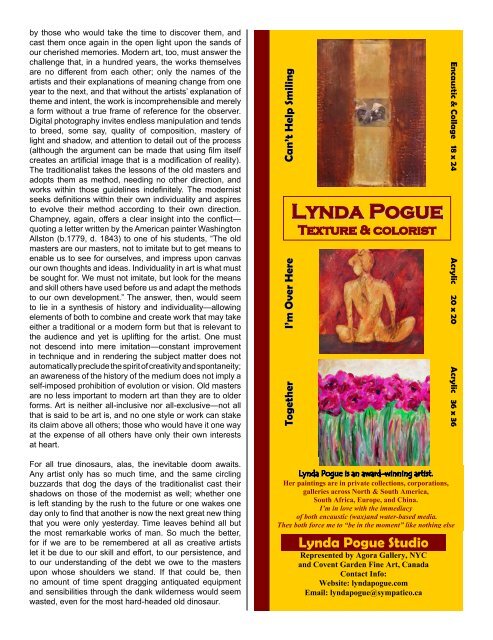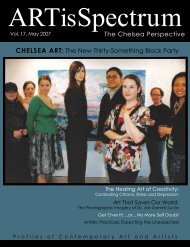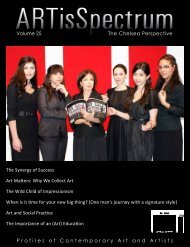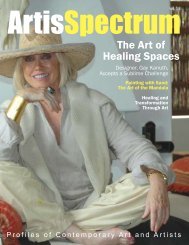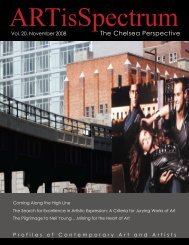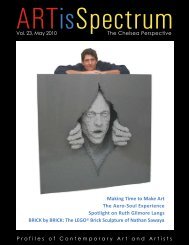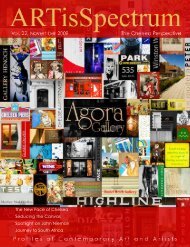Download PDF - ARTisSpectrum
Download PDF - ARTisSpectrum
Download PDF - ARTisSpectrum
You also want an ePaper? Increase the reach of your titles
YUMPU automatically turns print PDFs into web optimized ePapers that Google loves.
y those who would take the time to discover them, and<br />
cast them once again in the open light upon the sands of<br />
our cherished memories. Modern art, too, must answer the<br />
challenge that, in a hundred years, the works themselves<br />
are no different from each other; only the names of the<br />
artists and their explanations of meaning change from one<br />
year to the next, and that without the artists’ explanation of<br />
theme and intent, the work is incomprehensible and merely<br />
a form without a true frame of reference for the observer.<br />
Digital photography invites endless manipulation and tends<br />
to breed, some say, quality of composition, mastery of<br />
light and shadow, and attention to detail out of the process<br />
(although the argument can be made that using film itself<br />
creates an artificial image that is a modification of reality).<br />
The traditionalist takes the lessons of the old masters and<br />
adopts them as method, needing no other direction, and<br />
works within those guidelines indefinitely. The modernist<br />
seeks definitions within their own individuality and aspires<br />
to evolve their method according to their own direction.<br />
Champney, again, offers a clear insight into the conflict—<br />
quoting a letter written by the American painter Washington<br />
Allston (b.1779, d. 1843) to one of his students, “The old<br />
masters are our masters, not to imitate but to get means to<br />
enable us to see for ourselves, and impress upon canvas<br />
our own thoughts and ideas. Individuality in art is what must<br />
be sought for. We must not imitate, but look for the means<br />
and skill others have used before us and adapt the methods<br />
to our own development.” The answer, then, would seem<br />
to lie in a synthesis of history and individuality—allowing<br />
elements of both to combine and create work that may take<br />
either a traditional or a modern form but that is relevant to<br />
the audience and yet is uplifting for the artist. One must<br />
not descend into mere imitation—constant improvement<br />
in technique and in rendering the subject matter does not<br />
automatically preclude the spirit of creativity and spontaneity;<br />
an awareness of the history of the medium does not imply a<br />
self-imposed prohibition of evolution or vision. Old masters<br />
are no less important to modern art than they are to older<br />
forms. Art is neither all-inclusive nor all-exclusive—not all<br />
that is said to be art is, and no one style or work can stake<br />
its claim above all others; those who would have it one way<br />
at the expense of all others have only their own interests<br />
at heart.<br />
Together I’m Over Here Can’t Help Smiling<br />
Lynda Pogue<br />
Texture & colorist<br />
Encaustic & Collage 18 x 24 Acrylic 20 x 20 Acrylic 36 x 36<br />
For all true dinosaurs, alas, the inevitable doom awaits.<br />
Any artist only has so much time, and the same circling<br />
buzzards that dog the days of the traditionalist cast their<br />
shadows on those of the modernist as well; whether one<br />
is left standing by the rush to the future or one wakes one<br />
day only to find that another is now the next great new thing<br />
that you were only yesterday. Time leaves behind all but<br />
the most remarkable works of man. So much the better,<br />
for if we are to be remembered at all as creative artists<br />
let it be due to our skill and effort, to our persistence, and<br />
to our understanding of the debt we owe to the masters<br />
upon whose shoulders we stand. If that could be, then<br />
no amount of time spent dragging antiquated equipment<br />
and sensibilities through the dank wilderness would seem<br />
wasted, even for the most hard-headed old dinosaur.<br />
Lynda Pogue is an award-winning artist.<br />
Her paintings are in private collections, corporations,<br />
galleries across North & South America,<br />
South Africa, Europe, and China.<br />
I’m in love with the immediacy<br />
of both encaustic (wax)and water-based media.<br />
They both force me to “be in the moment” like nothing else<br />
Lynda Pogue Studio<br />
Represented by Agora Gallery, NYC<br />
and Covent Garden Fine Art, Canada<br />
Contact Info:<br />
Website: lyndapogue.com<br />
Email: lyndapogue@sympatico.ca


